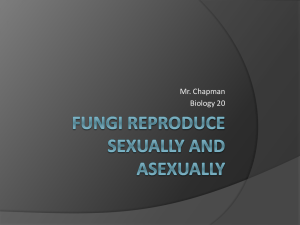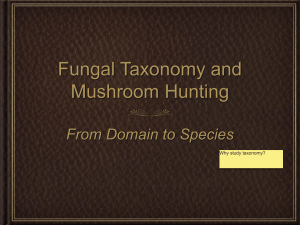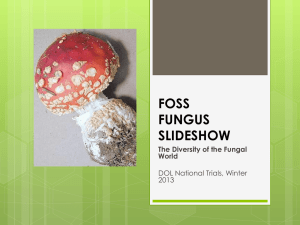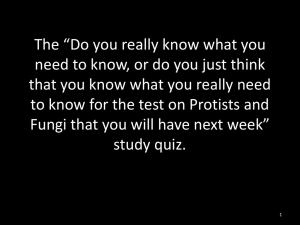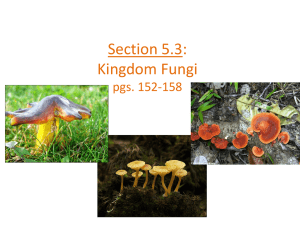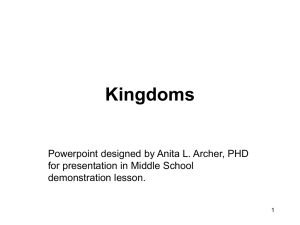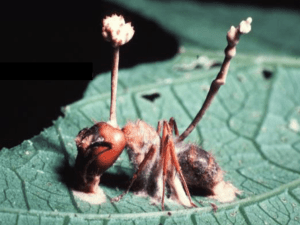File
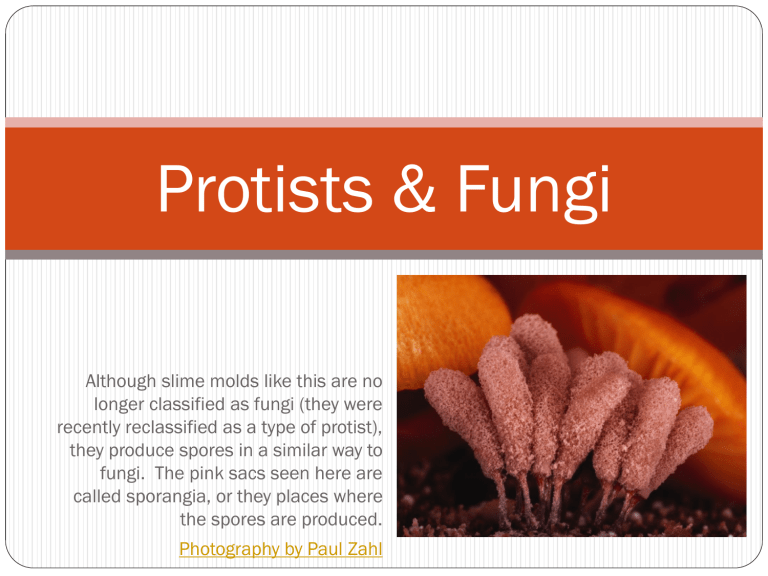
Protists & Fungi
Although slime molds like this are no longer classified as fungi (they were recently reclassified as a type of protist), they produce spores in a similar way to fungi. The pink sacs seen here are called sporangia, or they places where the spores are produced.
Photography by Paul Zahl
Introduction
On the following slides, the summary color is in orange and all vocabulary terms are underlined.
The kingdom Protista is probably the most diverse group of organisms on the planet.
Although previously classified in the plant kingdom, fungi are unlike plants because they lack chlorophyll , so they are always heterotrophs.
In this unit will we review details of both the Protist and the Fungi kingdoms.
Protists
Some are microscopic and others grow to be meters long.
Some act like animals, while some act like plants.
Some are poisonous and others are parasitic.
This protist Trichonympha lives in the gut of termites to digest the cellulose of wood. Image
Protists Foldable
Turn to pg. 503 in the textbook.
Pick up one sheet of computer paper to build our Protist foldable.
Write your name in the lower center of the back of the page. http://www.tulane.edu/~wiser/protozoology/notes/protist.gif
Protist Foldable Instructions
1.
2.
3.
4.
Fold your paper in half along the X axis, but leave a
½ inch flap at the bottom edge [one side is longer than the other].
Fold the flap upwards.
Create a title for the foldable at the top of your foldable: EX “All about Protists”, “World of
Protists”, etc.
Create three cuts in the foldable on the top, large flap and the short small flap [DO NOT cut through the back page].
Foldable Instructions Cont.
5.
Title the OUTSIDE, smaller flaps from L to R:
Animal-like
Plant-like
Fungi-like
6.
7.
Title the INSIDE, smaller flaps from L to R:
Protozoa (pg. 504)
Algae (pg. 511)
Slime Molds, etc. (pg. 517)
Add three sketches to represent each of the types of protists on outside, larger flaps.
Foldable Part 1 – Protozoa
Textbook Reference pg. 504-509
On the inside flap, answer the following questions using the textbook reading section.
Cell Type [Unicellular, Multicellular, or Both]
Energy Type [Autotrophs or Heterotrophs]
Reproduction [Asexual, Sexual, or Both]
3 Types of Movement [w/ a short explanation]:
Pseudopodia
Flagellates
Ciliates
A fisher gathers up algae to remove it from the water in
Qingdao on July 6. The North China Sea Marine
Forecasting Center recently predicted the thick masses of algae would continue spreading north, according to
Xinhua. Photograph from ChinaFotoPress
Foldable Part 2 – Algae
Textbook Reference pg. 510-516
On the inside flap, answer the following questions using the textbook reading section..
Cell Type [Unicellular, Multicellular, or Both]
T or F: Plant-like protists contain roots, stems, and leaves like plants.
Energy Type [Autotrophs or Heterotrophs]
T or F: Plant-like protists photosynthesize.
T or F: Plant-like protists contain chlorophyll.
Types of Algae[w/ a short explanation]:
Euglenoids: Unlike plants, they lack a _____ _____; movement using _________.
Diatoms: shells composed of _____; AKA ________ in aquatic ecosystems.
Dinoflagellates: Cell walls of _________; some are _________
[means “living light’], but many are _________ causing red tides.
Red, Brown, & Green Algae: Includes seaweeds and kelp, but can also be found growing on _______ soil and tree _________.
Video
The Blob (1958 )
Movie Clip
Image
From “Top Ten
Weirdest Stories of
2012”
The living slime that may have been the muse for the 1958 science-fiction film The
Blob just got creepier:
In October, scientists reported that slime mold, a brainless single-celled organism, has a form of memory.
Photograph by Audrey
Dussutour
Foldable Part 3 – Slime Molds, Etc.
Textbook Reference pg. 517-520
On the inside flap, answer the following questions using the textbook reading section..
Cell Type [Unicellular, Multicellular, or Both]
Energy Type [Autotrophs or Heterotrophs]
T or F: Fungi-like protists are decomposers.
3 Types [w/ a short explanation]:
Slime Molds: Live in _____, _____, _____ places.
Water Molds & Downy Mildews: Live in _____ or _____ places; can cause __________.
Briefly explain the example from Ireland beginning in 1845.
Diseases Caused by Protists
Textbook Reference pg. 508-509
Sporozoans have no structure for movement because they are parasitic; they are more complex and usually involve more than one host.
EX Plasmodium - causes malaria and infects both mosquitoes and humans.
EX Amebic dysentery ( Giardia) from infected water will cause severe diarrhea, nausea and fatigue; attaches to the host's intestinal lining.
There are estimates that there may be as many as 2.5 million cases each year of Giardia intestinalis in the US alone(6). A single-celled protozoa, the parasite also poses a serious threat abroad, and exists at very high prevalence rates particularly in places with poor water sanitation. Image
Protists in the Biosphere
Take a deep breath! Thank a protist!
Phytoplankton are microscopic organisms that float near the surface of oceans and lakes and carry out more than 70% of the Earth's total photosynthesis
(contributing to the oxygen in our environment).
Fungi
Laetiporus sulphureus
Photograph by Dan Molter
Fungi are important in the fact that they recycle materials back into the soil to replenish it for other organisms; as decomposers they are essential elements in the ecosystems of Earth.
Fungi Photography
Fungi Podcast
What is a fungus?
Mycology = the study of Fungi
Fungi – singular
Fungus – plural
Key Characteristics:
Eukaryotic [w/ nuclei, mitochondria, and other organelles]
Heterotrophs [ decomposing “feeders”]
Multicellular
Cannot move on their own
How are fungi different from plants?
4 Reasons:
Lack chlorophyll [the green pigment in chloroplasts]
Therefore they are NOT photosynthetic
Most are saphrophytes [“feeds” on dead or decaying matter]
Some are parasites
Never reproduce by seeds
Most have cell walls of chitin, except molds [NOT cellulose]
Parts of Fungi
Hypha (s) = a network of thin thread-like structures that form the “body” of a fungus; hyphae (p)
hyphae grow and branch until they cover and digest the food source
Germ tube
(growing spore)
(initial hypha)
Single hypha
Mass of hyphae
(mycelium)
Parts of Fungi Cont.
Mycelium (s) = mass of hyphae; mycelia (p)
usually hidden in the soil, in wood, or another food source
may fill a single ant, or cover many acres
The Types of Fungi
Zygomucotes Ascomycotes Basidiomycotes Deuteromycotes mold
reproduce asexually & sexually
Sporangia – structures on the tips of hyphae; make spores
Rhizoids hyphae of bread mold that digest bread for ingestion
EX Bread mold sac fungi
reproduce asexually & sexually
Ascus- tiny saclike structures that make spores
EX Yeast club-shaped part which produces the spores
reproduce asexually & sexually
Mushrooms can release large clouds of spores.
Each cloud contains millions of spores
EX Mushrooms
Imperfect fungi
currently only known to reproduce asexually
cause most fungal diseases in humans
EX Athlete’s foot
The Four Types of Fungi
Zygomucotes Ascomycotes Basidiomycotes Deuteromycotes mold
reproduce asexually & sexually
Sporangia – structures on the tips of hyphae; make spores
Rhizoids hyphae of bread mold that digest bread for ingestion
EX Bread mold sac fungi
reproduce asexually & sexually
Ascus- tiny saclike structures that make spores
EX Yeast club-shaped part which produces the spores
reproduce asexually & sexually
Mushrooms can release large clouds of spores.
Each cloud contains millions of spores
EX Mushrooms
Imperfect fungi
currently only known to reproduce asexually
cause most fungal diseases in humans
EX Athlete’s foot
The Four Types of Fungi
Zygomucotes Ascomycotes Basidiomycotes Deuteromycotes mold
reproduce asexually & sexually
Sporangia – structures on the tips of hyphae; make spores
Rhizoids hyphae of bread mold that digest bread for ingestion
EX Bread mold sac fungi
reproduce asexually & sexually
Ascus- tiny saclike structures that make spores
EX Yeast club-shaped part which produces the spores
reproduce asexually & sexually
Mushrooms can release large clouds of spores.
Each cloud contains millions of spores
EX Mushrooms
Imperfect fungi
currently only known to reproduce asexually
cause most fungal diseases in humans
EX Athlete’s foot
The Four Types of Fungi
Zygomucotes Ascomycotes Basidiomycotes Deuteromycotes mold
reproduce asexually & sexually
Sporangia – structures on the tips of hyphae; make spores
Rhizoids hyphae of bread mold that digest bread for ingestion
EX Bread mold sac fungi
reproduce asexually & sexually
Ascus- tiny saclike structures that make spores
EX Yeast club-shaped part which produces the spores
reproduce asexually & sexually
Mushrooms can release large clouds of spores.
Each cloud contains millions of spores
EX Mushrooms
Imperfect fungi
currently only known to reproduce asexually
cause most fungal diseases in humans
EX Athlete’s foot
Fungi Foldable
Turn to pg. 535 in the textbook.
Pick up one sheet of computer paper to build our
Fungi foldable.
Write your name in the middle of the back of the page. http://content63.eol.org/content/2011/11/03/02/57753_orig.jpg
Fungi Foldable Instructions
1.
2.
3.
4.
Fold your paper in half along the X axis.
Then fold the top and bottom edges to meet in the middle.
Fold the foldable in half along the Y axis.
Open and cut along the middle, vertical fold; you should now have four flaps.
5.
Title the OUTSIDE flaps clockwise for the upper left:
Zygomycotes [AKA Molds]
Ascomycotes [AKA Sac Fungi]
Basidiomycotes [AKA Mushrooms]
Deuteromycotes
Foldable Part 1 – Zygomycotes
Textbook Reference pg. 535-536
On the inside flap, answer the following questions using the textbook reading section.
Familiar Examples
Reproduction [Asexual, Sexual, or Both]
Sketch the reproductive cycle diagram at the bottom of pg. 536
[including labels].
Key Vocabulary:
Stolon
Rhizoid
Foldable Part 2 – Ascomycotes
Textbook Reference pg. 537
On the inside flap, answer the following questions using the textbook reading section..
Familiar Examples
Reproduction [Asexual, Sexual, or Both]
Key Vocabulary:
Ascus
Ascospores
Conidiophores
Conidia http://content60.eol.org/content/2012/06/12/07/64006_orig.jpg
Foldable Part 3 – Basidiomycotes
Textbook Reference pg. 535-536
On the inside flap, answer the following questions using the textbook reading section.
Familiar Examples
Reproduction [Asexual, Sexual, or Both]
Sketch the diagram of a mushroom cap and stalk at the bottom of pg. 539 [including labels for gill, basidia, and basidiospores].
Key Vocabulary:
Basidia
Basidiospores
Foldable Part 4 – Deuteromycotes
Textbook Reference pg. 535-536
On the inside flap, answer the following questions using the textbook reading section.
Familiar Examples
Reproduction [Asexual, Sexual, or Both]
Fungi are used to make the antiobiotic penicillin.
Penicillium marneffei
Image
Diseases Caused by Fungi
Textbook Reference pg. 546
Fungal diseases are estimated to be responsible for between 15 to 50% of the world’s crop loss.
EX black stem rust [infects wheat, rice ], corn smut, and ergot [Salem Witch Trials]
Human pathogens
The microorganism Candida albicans is responsible for ringworm, athletes foot, and yeast infections of the female reproductive tract.
